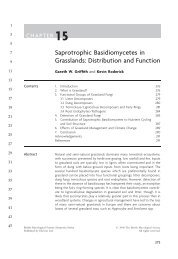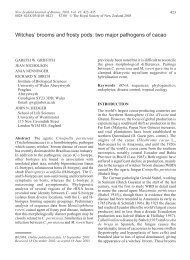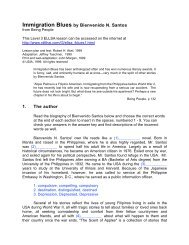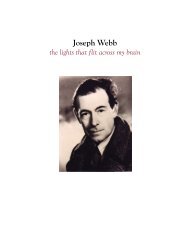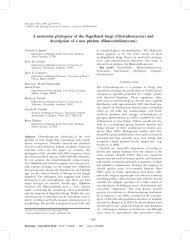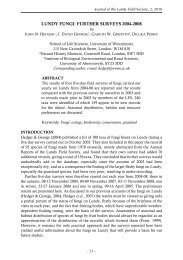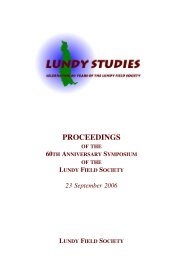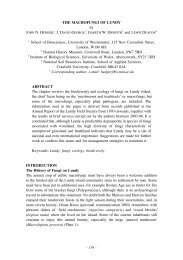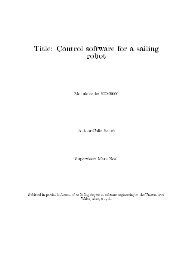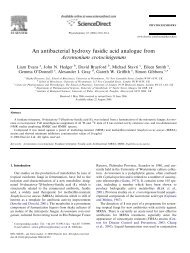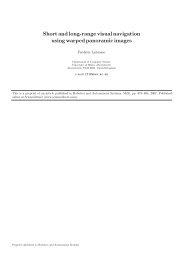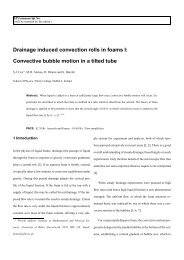Anaerobic rumen fungi
Anaerobic rumen fungi
Anaerobic rumen fungi
Create successful ePaper yourself
Turn your PDF publications into a flip-book with our unique Google optimized e-Paper software.
ANAEROBIC RUMEN FUNGI<br />
Orpinomyces) were closely related based on the ultrastructure of the zoospores. Unfortunately,<br />
various problems including the presence of divergent ITS sequences within individual isolates<br />
has hampered widespread use of this locus for taxonomic studies (Ozkose, 2001), though PCR<br />
amplification of DNA from environmental samples (<strong>rumen</strong> fluid, digesta etc.) using ITS primers<br />
may prove valuable for ecological studies (Tuckwell et al. 2005).<br />
Counts of individual zoospores and zoosporangia have been used to estimate fungal<br />
populations in vitro (Joblin, 1981) and in vivo (Ushida et al. 1989). Breton et al. (1991) used colonyforming<br />
units per gram dry weight of faeces as the basis for quantifying species of Piromyces. An<br />
endpoint dilution practice, based on the technique of most probable numbers, was developed to<br />
enumerate <strong>rumen</strong> <strong>fungi</strong> as thallus-forming units (Theodorou et al. 1990). The procedure involves<br />
a 10-fold dilution series of sample in an antibiotic-containing basal anaerobic medium. Defined<br />
medium plus 10% clarified <strong>rumen</strong> fluid was used for dilution series, and fungal population<br />
represented as thallus-forming units per gram of dry weight.<br />
An indirect method based on zoospore concentration and life cycle parameters has been used<br />
to quantify <strong>fungi</strong> in the <strong>rumen</strong>. Exploiting the life history parameters and growth kinetics of these<br />
<strong>fungi</strong>, France et al. (1990) proposed a mathematical model of the life cycle in a steady state so that<br />
the population of the particle-attached fungal thalli could be calculated from the concentration of<br />
free-swimming zoospores in <strong>rumen</strong> fluid. The values obtained were reliable for samples from<br />
<strong>rumen</strong> and faeces. However, the inadequate knowledge of the life cycle of anaerobic <strong>fungi</strong> makes<br />
it complicated to evaluate the consistency of this technique.<br />
For long-term maintenance of these <strong>fungi</strong>, cultures are usually stored in liquid nitrogen using<br />
anaerobic glycerol as the cryoprotectant. Pure cultures of anaerobic <strong>fungi</strong> can also be maintained<br />
in a defined medium consisting of cell-free <strong>rumen</strong> fluid, tryptone, yeast extract, a carbon source,<br />
buffer, L-cysteine as the reducing agent, and vitamins (Wubah et al. 1991a). Neocallimastix frontalis<br />
has been maintained in a similar medium but without the yeast extract and <strong>rumen</strong> fluid (Lowe et<br />
al. 1985). For prolonged maintenance in the laboratory, pure cultures of anaerobic <strong>fungi</strong> are<br />
transferred into fresh basal anaerobic medium every 3-4 days. Joblin (1981), however, reported<br />
that cultures could be maintained for several months on plant tissues stored at 39°C without subculturing.<br />
Yarlett et al. (1986) reported cryopreservation of the anaerobic fungus Neocallimastix<br />
patriciarum at -80°C with dimethyl sulphoxide as the cryoprotectant, but the survival rate was<br />
only 40% after one year. However, in a similar study by Sakurada et al. (1995), the survival<br />
reached 80% after one year of storage at -84°C with ethylene glycol and cell-free <strong>rumen</strong> fluid.<br />
14. FUTURE PROSPECTS<br />
Rumen microbiologists have constantly shown curiosity in manipulation of the <strong>rumen</strong><br />
microbial ecosystem to boost feedstuff utilization and improved milk production. It is now a wellestablished<br />
fact that anaerobic <strong>fungi</strong> participate in hydrolysis of plant biomass in ruminants,<br />
based on superior penetration of plant tissues over bacteria or protozoa, and thus leading to an<br />
enhanced degradation of forage in the <strong>rumen</strong>. These <strong>fungi</strong> are well equipped with enzymes<br />
important for <strong>rumen</strong> fermentation, and represent group of dynamic cellulolytic organisms that<br />
explicitly colonize fibrous plant fragments. The properties taken together with perceptible extent<br />
of <strong>rumen</strong> populations in animals on high-fibre diets indicates a significant role of such<br />
heterotrophs in fibre digestion. In addition, <strong>fungi</strong> may bring special changes to plant materials in<br />
the <strong>rumen</strong> with the resultant improved feed intake, body weight gain, enhanced milk output, and<br />
improved animal productivity. As efforts are still in its early stages regarding stimulation of<br />
<strong>rumen</strong> fermentation by anaerobic <strong>fungi</strong>, more studies are imperative to assess the extent of their<br />
385



